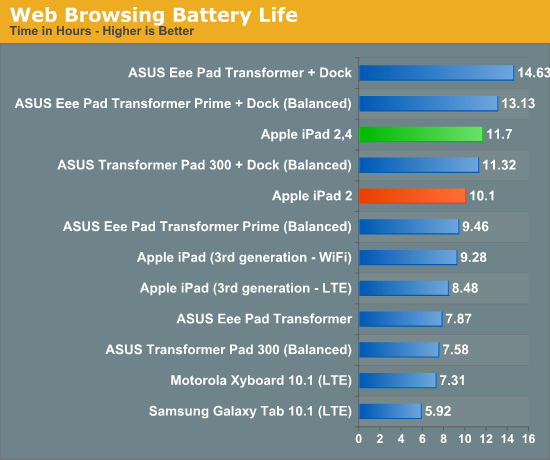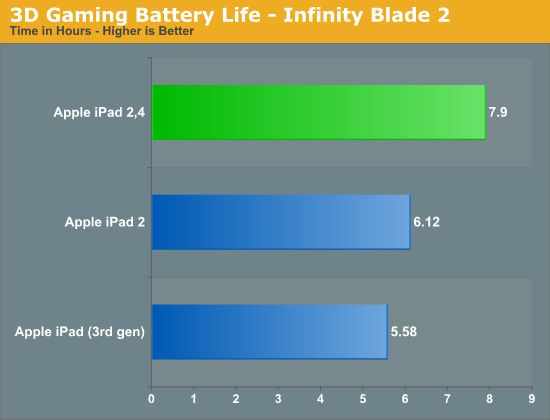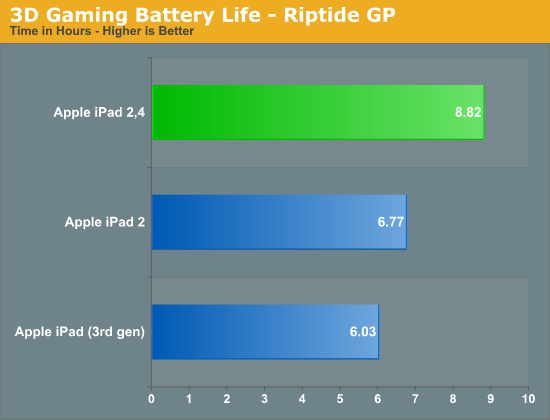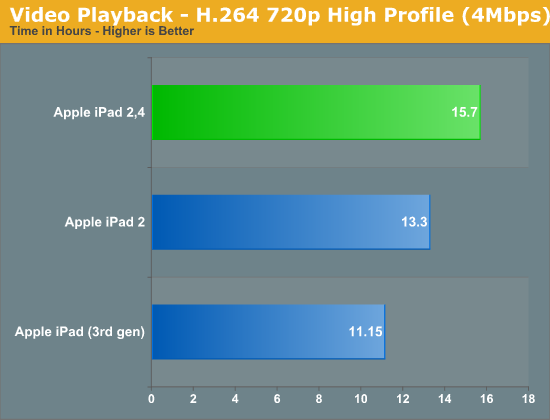The iPad 2,4 Review: 32nm Brings Better Battery Life
by Anand Lal Shimpi on May 4, 2012 12:50 AM ESTSignificant Battery Life Improvements
We'll start with the latest iteration of our WiFi web browsing test. With some additional logic to defeat overly aggressive browser caching, this test cycles through dozens of web pages, pausing on each one to simulate reading time before moving onto the next one. Display brightness is kept constant at 200 nits while the test runs. Results are reported in hours of battery life before the tablet dies.

Most web browsing tests end up being significantly display limited, as in the display dominates most of the power draw. That being the case, the fact that we see a 15.8% increase in battery life from the new 32nm HK+MG SoC alone is very significant. Apple is very conservative internally about revising battery life ratings so it's no surprise that we don't see a change in the specs on the iPad 2, especially considering that so many units out there on the market are still older iPad 2,1 models.
The increase in battery life here is almost certainly due to lower leakage at idle and better active power as well. This is a real improvement.
Things get even better when we stress the real power hog on the SoC: Imagination Technologies' PowerVR SGX 543MP2 GPU. Taking up more area on the die than the dual Cortex A9 cores, the 543MP2 is really stressed during 3D gaming. What better way to measure the impact of the new 32nm SoC on battery life than with one of the most stressful 3D games out for iOS today: Infinity Blade 2.
Here we're looping through the same scene until the battery dies, once again at normalized brightness.

The 3rd generation iPad obviously doesn't do as well as the iPad 2 here, as it not only has a more power hungry GPU but it's also rendering the scene at a higher resolution (and driving a higher resolution panel). What's most impressive however is just how much better the iPad 2,4 does here: a 29% increase in battery life over the original iPad 2,1.
Riptide GP, a less stressful title, shows us similar results:

Finally we have our brand new video playback test. Here we've got a copy of the last Harry Potter movie with the credits stripped out (1:58:00 running time), transcoded to a 720p High Profile H.264 video with a 4Mbps average bit rate, playing back in a loop until the battery dies.

The iPad 2 holds a 19% advantage over the 3rd generation iPad (once again for obvious reasons), however the iPad 2,4 absolutely dominates with an 18% increase in battery life. At 15.7 hours this is an insane amount of battery life from a single charge. Granted end users will see lower numbers if you watch at higher brightness settings (200 nits on our test panel was around 40% brightness), but the advantage from the new iPad should still remain just as significant.










100 Comments
View All Comments
Tuvok86 - Friday, May 4, 2012 - link
do you think Apple will introduce the 32nm soc on iPad 3 silently or they will wait for the next iteration?guidryp - Friday, May 4, 2012 - link
"Note that idle power is actually higher than video playback simply because there's more that's being driven on the display, at a higher intensity on the iOS home screen than on a dark 16:9 video."That really doesn't make sense. This is LCD, not OLED. Displaying black/white should take about the same amount of power, because the backlight is uniform and covers the whole display. It doesn't turn off on dark areas of the screen.
Perhaps Apple cheats and turns down the brightness while a movie plays. Create a movie that has a pure white screen and measure nits...
André - Friday, May 4, 2012 - link
No need to call shenanigans. You simply failed to read what was written.It isn't the screen that uses less power but the SoC because it has dedicated hardware for video playback.
guidryp - Friday, May 4, 2012 - link
He is clearly talking about screen content, when he mentions "dark 16:9 video" which implies that power changes drastically dependent on what is displayed.This is true for OLED screens, but untrue for LCD screens.
Also while dedicated Video decode HW offloads work from CPU/GPU, they essentially have no work to offload while idle. Really great dedicated Video decode HW could get you to idle consumption, but I don't see how it could get you below idle.
Something very strange here.
PeteH - Friday, May 4, 2012 - link
What about bandwidth? 8-bit 4:2:0 video is a bit less than 40% of the size of 8-bit ARGB (for equivalent source dimensions).Anand Lal Shimpi - Friday, May 4, 2012 - link
There could be a handful of things happening here:1) It is possible to have a small reduction in LCD power consumption by displaying black vs. white. The gap isn't anywhere near as dramatic as it can be on an OLED display, but it can be measurable. This alone can't explain the difference, I agree.
2) It's possible that Apple is putting the SoC into an even lower power state when a video playback scenario is triggered. Apple does quite a bit of aggressive power management so this wouldn't be too far fetched.
3) It's not clear to me if Apple is doing any localized dimming, which would have a significant impact on video decode power consumption.
Take care,
Anand
guidryp - Friday, May 4, 2012 - link
I think the back-light as the largest power draw (especially in idle), is the easiest source of savings. Displaymate measured 7watts at max for the back-light alone on iPad 3 !Easy reductions either from a simple general brightness reduction when a movie is playing, or dynamic backlight control while a movie is playing. Done right it gets some savings while being hard to notice.
I really don't think you can get a much lower power state while playing video, than while just displaying a start screen. In either case the CPU is still running, still instantly ready for touch, or sensor reactions.
However they did it, it is a slick piece of engineering.
Pshooter - Friday, May 4, 2012 - link
http://www.displaymate.com/iPad_ShootOut_1.htmBSMonitor - Friday, May 4, 2012 - link
"This particular iPad 2,4 sample came from Best Buy, and several attempts to find one elsewhere came up short. All indications seem to point to the iPad 2,4 being relatively rare, which makes sense considering what's inside it."Was one of the other attempts Apple's own website??
Anand Lal Shimpi - Friday, May 4, 2012 - link
The other tries were at an Apple store (3x) and a Walmart (1x).Take care,
Anand